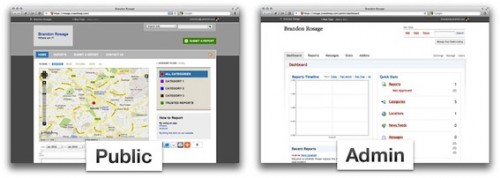Designing Ushahidi: Events and Personas

Jul 3, 2012

We've been blogging and talking directly with our community about ongoing feedback. How can we improve our software? We've been collecting your feedback via Github Issues, some user interviews, conversations in person, via the community wiki, videos and forums. (Thank you.) This is the first in a series of blog posts about upcoming Ushahidi software development changes. Today, we'll focus on the overall design, continue to explore the user base and features requested by the various groups from election monitoring to crisis/emergency response to civil society. We're looking for more input in person and virtually as we continue down this road.
Upcoming Design events:
We are hosting two Design Jams next week in Seattle and Nairobi. Join us if you are in these areas.  The Jam: How can we reduce the abstraction between administrative functions (for deployers) and public user functions (like reading reports and filtering by category)? Challenge: Create wireframe or mockup of a Ushahidi or Crowdmap deployment that provides the necessary functionality to users on large- and small-screen devices with minimal abstraction between administrative and public functions. Many of the most popular services on the web offer powerful content management and customization tools that remain intuitive to both experienced and first-time users. The events will be held on Tuesday, July 10th, 2012. To register: Nairobi and Seattle More details on the wiki
The Jam: How can we reduce the abstraction between administrative functions (for deployers) and public user functions (like reading reports and filtering by category)? Challenge: Create wireframe or mockup of a Ushahidi or Crowdmap deployment that provides the necessary functionality to users on large- and small-screen devices with minimal abstraction between administrative and public functions. Many of the most popular services on the web offer powerful content management and customization tools that remain intuitive to both experienced and first-time users. The events will be held on Tuesday, July 10th, 2012. To register: Nairobi and Seattle More details on the wiki
What is your User Persona:
(From Gabriel White, Small Surfaces)
As we start making the next big version of Ushahidi we want to make sure we stay focused on real user needs. To do this, we spent time talking with the people who actually use the software. We spoke with them about their needs, the challenges they face and their aspirations for what they would like to be able to do with Ushahidi in the future. With this understanding in hand, we created design tools called 'Personas' and 'Scenarios'. A personas is a description of a person that includes information about their goals, motivations and needs as they relate to a product (in this case Ushahidi). Scenarios are descriptions of the most important activities people need to be able to carry out when using the software. Creating these helps make sure we remain focused on real user needs as we design Ushahidi 3.0. What's important to keep in mind when creating Personas and Scenarios is that these artefacts should not capture everything, but rather the most important needs and the most important uses. Again, this helps us stay focused on what's most important, and avoid the distractions of nice-to-have features. This will help us make sure that the software, at its core, is addressing the most important needs successfully. After that, we can start thinking about how to include other value-add features.
Ushahidi personas scenarios
View more presentations from Ushahidi
As you look at the personas, don't expect to see one that is an exact reflection of your role or your project. What's important to think about is: how the personas and scenarios overall capture the different kinds of needs and uses that you have as you use the software. There might not a perfect match for you with a persona, but we hope that you can see your needs reflected generally throughout them. ****** Let us know what you think. Heather